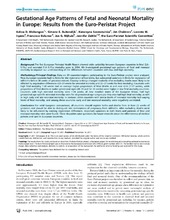| dc.contributor.author | Mohangoo, Ashna D. | en_US |
| dc.contributor.author | Buitendijk, Simone E. | en_US |
| dc.contributor.author | Szamotulska, Katarzyna | en_US |
| dc.contributor.author | Chalmers, Jim | en_US |
| dc.contributor.author | Irgens, Lorentz M. | en_US |
| dc.contributor.author | Bolumar, Francisco | en_US |
| dc.contributor.author | Nijhuis, Jan G. | en_US |
| dc.contributor.author | Zeitlin, Jennifer | en_US |
| dc.date.accessioned | 2012-02-27T14:12:18Z | |
| dc.date.available | 2012-02-27T14:12:18Z | |
| dc.date.issued | 2011-11-16 | eng |
| dc.Published | PLoS ONE 6(11): e24727 | en |
| dc.identifier.issn | 1932-6203 | |
| dc.identifier.uri | https://hdl.handle.net/1956/5649 | |
| dc.description.abstract | Background: The first European Perinatal Health Report showed wide variability between European countries in fetal (2.6– 9.1%) and neonatal (1.6–5.7%) mortality rates in 2004. We investigated gestational age patterns of fetal and neonatal mortality to improve our understanding of the differences between countries with low and high mortality. Methodology/Principal Findings: Data on 29 countries/regions participating in the Euro-Peristat project were analyzed. Most European countries had no limits for the registration of live births, but substantial variations in limits for registration of stillbirths before 28 weeks of gestation existed. Country rankings changed markedly after excluding deaths most likely to be affected by registration differences (22–23 weeks for neonatal mortality and 22–27 weeks for fetal mortality). Countries with high fetal mortality $28 weeks had on average higher proportions of fetal deaths at and near term ($37 weeks), while proportions of fetal deaths at earlier gestational ages (28–31 and 32–36 weeks) were higher in low fetal mortality countries. Countries with high neonatal mortality rates $24 weeks, all new member states of the European Union, had high gestational age-specific neonatal mortality rates for all gestational-age subgroups; they also had high fetal mortality, as well as high early and late neonatal mortality. In contrast, other countries with similar levels of neonatal mortality had varying levels of fetal mortality, and among these countries early and late neonatal mortality were negatively correlated. Conclusions: For valid European comparisons, all countries should register births and deaths from at least 22 weeks of gestation and should be able to distinguish late terminations of pregnancy from stillbirths. After excluding deaths most likely to be influenced by existing registration differences, important variations in both levels and patterns of fetal and neonatal mortality rates were found. These disparities raise questions for future research about the effectiveness of medical policies and care in European countries. | en_US |
| dc.language.iso | eng | eng |
| dc.publisher | Public Library of Science | eng |
| dc.rights | Attribution CC BY | eng |
| dc.rights.uri | http://creativecommons.org/licenses/by/2.5/ | eng |
| dc.title | Gestational Age Patterns of Fetal and Neonatal Mortality in Europe: Results from the Euro-Peristat Project | en_US |
| dc.type | Peer reviewed | |
| dc.type | Journal article | |
| dc.description.version | publishedVersion | en_US |
| dc.rights.holder | Copyright 2011 Mohangoo et al. | |
| dc.identifier.doi | https://doi.org/10.1371/journal.pone.0024727 | |
| dc.subject.nsi | VDP::Medical disciplines: 700::Health sciences: 800 | eng |

